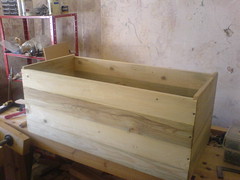The method of putting your fingers under the sole as a fence is surely for those who have a cambered blade, using the plane's position side to side to tune up the angle minutely. With a flat blade it's a bit pointless. I mean they put a handle there to hold onto didn't they?
It's also a good way to lose the skin off your knuckles on the vice jaws when you forget the workpiece is only 3x1 ! (I've done it)
However, how darned square does the edge need to be?? If you are just talking about the top edge of drawers, that is achievable by feel, planing to a line and using a try square, like wot we were taught. If however you are jointing boards, if you put them face to face it matters not a jot if they are even vaguely square if you plane both edges at the same time. Either way a no6 is the minimum length IMHO.
That's my two penn'orth. Back into the teapot for me. zzzzzzzzzz.





